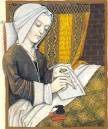Main Facts
She was one of the most famous women writers of the Middle Ages. Her feminist writings are groundbreaking. Her first poems, which were ballads, were a success. Her prose work consisted of biographies and practical advice for women; she often wrote about women’s heroism.
Intellectual Growth and Family
Christine de Pisan was born in Venice, Italy, in 1394. She moved to France with her father, the court astrologer of the French king Charles V. She grew up in an environment that enabled her to access great literary, scientific, and philosophical works. Her father was also supportive of her educational development. When she was about 15, she married a member of the French court, Etienne du Castel, who also encouraged her to grow intellectually. She had three children with him, but he died in 1389. Christine started writing in order to sustain her family: her two children, her mother, and a niece.
A Notable Writing Career
Fortunately, her love ballads appealed to patrons of the French royal court. Thanks to the support of Louis I, two successive dukes of Burgundy, and Isabella of Bavaria, she became a prolific writer and affected English poetry during the 15th century. She employed a wide range of rhetorical and pioneering techniques that posed a challenge to the work of well-established authors of her time and guaranteed her success. She managed to establish herself as a writer of historical discourse, a literary field in which male writers were prevalent. Simone de Beauvoir is one of the scholars who have recently tried to restore her status as a writer.
Radical Works
She is particularly known for her radical works on women. In the Letter to the God of Loves (1399), she deals with the position of women in society and criticizes their portrayal in literary works. In The Book of the City of Ladies (1405), she describes important women from history and advocates gender equality. In the Treasure of the City Ladies (1405), she continues to write in favor of women and underlines that they can be empowered by playing a reconciliatory role in society.
Later Life
Her life was changed because of the Hundred Years War between France and England. After France lost the battle of Agincourt, she moved to a convent in Poissy, France. She did not write a lot while living there. In 1429, she created her final literary work, a tribute to Joan of Arc. Circa 1430, she died at the convent.



0 Comments